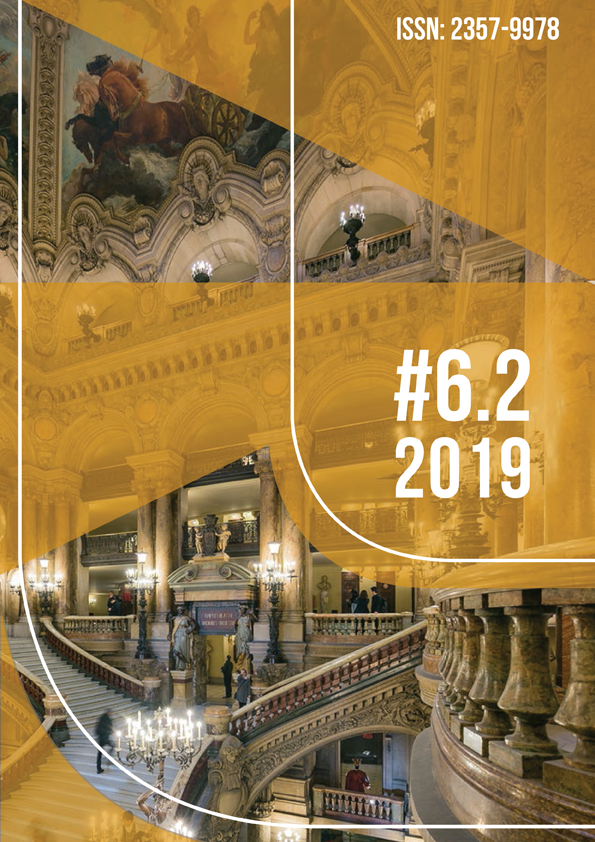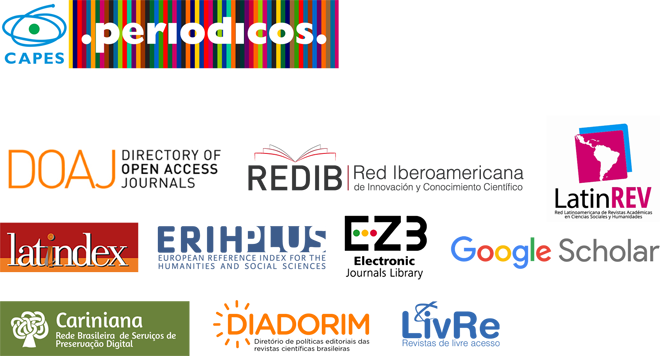Scores os irreconcilable temporality
DOI:
https://doi.org/10.36025/arj.v6i2.17279Keywords:
Visual arts, Fragment, Sonority, Visuality, ScoreAbstract
The work with scores of irreconcilable temporality investigates artistic productions that correlates music and painting, the principles of daily and fragmentary from the shape-score. The subject of shape-score appears as a concept that enables the relationship, offering an interface between sonorities and visualities. In this notion of shape-score the article try to establish the idea of situationist deriva with Guy Debord’s proposal to disarticulate the continuous flow of the city, as well as to elaborate a new cartography using the physical territories, making analogy with the musical compass. Each territory mapped by the Naked City consists of the overlapping of several sound layers from 1957 to 2014. From the map, the author established new derivas in 2014 and expanded the notion of map by understanding it as a score in the expanded sense. The idea of cartography is the musical apprehension of the city: to map, to create territories where the sonority can exist.
Downloads
References
BARTHES, Roland. O rumor da língua. In: ______. O óbvio e obtuso. Rio de Janeiro: Nova Fronteira, 1982.
BENJAMIN, W. Imagens do pensamento, o caráter destrutivo. In: ______. Rua de mão única. Obras escolhidas, vol II. São Paulo: Brasiliense, 1997.
BERNHARD, Thomas. O náufrago. 2 ed. São Paulo: Companhia das Letras, 2006.
BRECHT, George. Events. In: HENDRICKS, Jon (org.). O que é Fluxus e o que não é. Brasília: Centro Cultural Banco do Brasil; Detroit: Gilbert and Lila Silverman Fluxus Colletion Foundation, 2002.
CARNEIRO, Isabel Almeida. Naked City. In: Anais do 24º Encontro Nacional de Pesquisadores em Artes Plásticas. Santa Maria: ANPAP/PPGART/CAL/UFSM, 2015. ISSN: 2175-8212 [online]. Disponível em: http://anpap.org.br/anais/2015/simposios/s2/isabel_almeida_carneiro.pdf
CERTEAU, Michel de. A invenção do cotidiano. Petrópolis: Vozes, 2012.
DAVILA, Thierry. Marcher, créer. Paris: Éditions du Regard, 2002.
DEBORD, Guy. Rapport sur la construction des situations. Paris: Mille et une nuits, 2000.
DELEUZE, Gilles; GUATARRI, Félix. Personagem conceitual. In: ______. O que é a filosofia? São Paulo: Ed. 34, 1992.
JACQUES, Paola Berenstein. Apologia da deriva: escritos situacionistas sobre a cidade. Rio de Janeiro: Casa da Palavra, 2003.
ROÇA, Luciana Santos; TRAMONTANO, Marcelo. Polifonias, dissonâncias e ritmos: ouvir para construir cidades. V!rus, São Carlos, n. 9 [online], 2013. Disponível em: http://www.nomads.usp.br/virus/virus09/?sec=6&item=1&lang=pt. Acesso em: 18 mai. 2015.
LISSOVSKY, Maurício. A memória e as condições poéticas do acontecimento. In: GONDAR, Jô; DODEBEI, Vera. O que é memória social? Rio de Janeiro: Contracapa, 2005.
MACIUNAS, George. O que é Fluxus e o que não é. In: HENDRICKS, Jon (org.). O que é Fluxus e o que não é. Brasília: Centro Cultural Banco do Brasil; Detroit: Gilbert and Lila Silverman Fluxus Colletion Foundation, 2002.
MERLEAU-PONTY. O olho e o espírito. São Paulo: Cosac Naify, 2004.
RODRIGUES, Claudiney; CHAVES, Renan Paiva. O pensamento sonoro-visual de Walter Ruttman e a música de “Berlim: Sinfonia de uma metrópole” (1927). Doc On-line, n. 12, ago. 2012, p. 22-58. Disponível em http://www.doc.ubi.pt/12/dt_claudiney_carrasco.pdf. Acessado em: 20 maio 2015.
ROLNIK, Suely. Cartografia sentimental: transformações contemporâneas do desejo. Porto Alegre: Sulina; Editora da UFRGS, 2011.
RUSSOLO, Luigi. The art of noise: (Futurist Manifesto, 1913). [L’arte dei rumori, trad. Robert Filiou.] New York: Something Else Press, 1967.
SCHAFER, Murray. O ouvido pensante. São Paulo: UNESP, 1991.
SCHAFER, Murray. A afinação do mundo. Editora UNESP: São Paulo, 2012.
TIBERGHIEN, Gilles. Imaginário cartográ?co na arte contemporânea: sonhar o mapa nos dias de hoje. Revista do Instituto de Estudos Brasileiros, n. 57. São Paulo, dez. 2013, p. 233-252, p. 20. Disponível em: https://www.scielo.br/scielo.php?script=sci_arttext&pid=S0020-38742013000200010.
TIBERGHIEN, Gilles. Hodológico. Revista-Valise, Porto Alegre, v. 2., n. 3, jul. 2012. Disponível em: https://seer.ufrgs.br/RevistaValise/article/view/30563/18969.
WATTS, Robert. No Event, 1964. In: HENDRICKS, Jon (org.). O que é Fluxus e o que não é. Brasília: Centro Cultural Banco do Brasil; Detroit: Gilbert and Lila Silverman Fluxus Colletion Foundation, 2002.
Downloads
Published
How to Cite
Issue
Section
License
Copyright (c) 2020 Isabel Almeida Carneiro (Autor)

This work is licensed under a Creative Commons Attribution-NonCommercial-ShareAlike 4.0 International License.

This work is licensed under a Attribution-NonCommercial-ShareAlike 4.0 International (CC BY-NC-SA 4.0) License.
Authors retain copyright, while licensing their work under a Attribution-NonCommercial-ShareAlike 4.0 International (CC BY-NC-SA 4.0) License.


 English
English Português (Brasil)
Português (Brasil)
